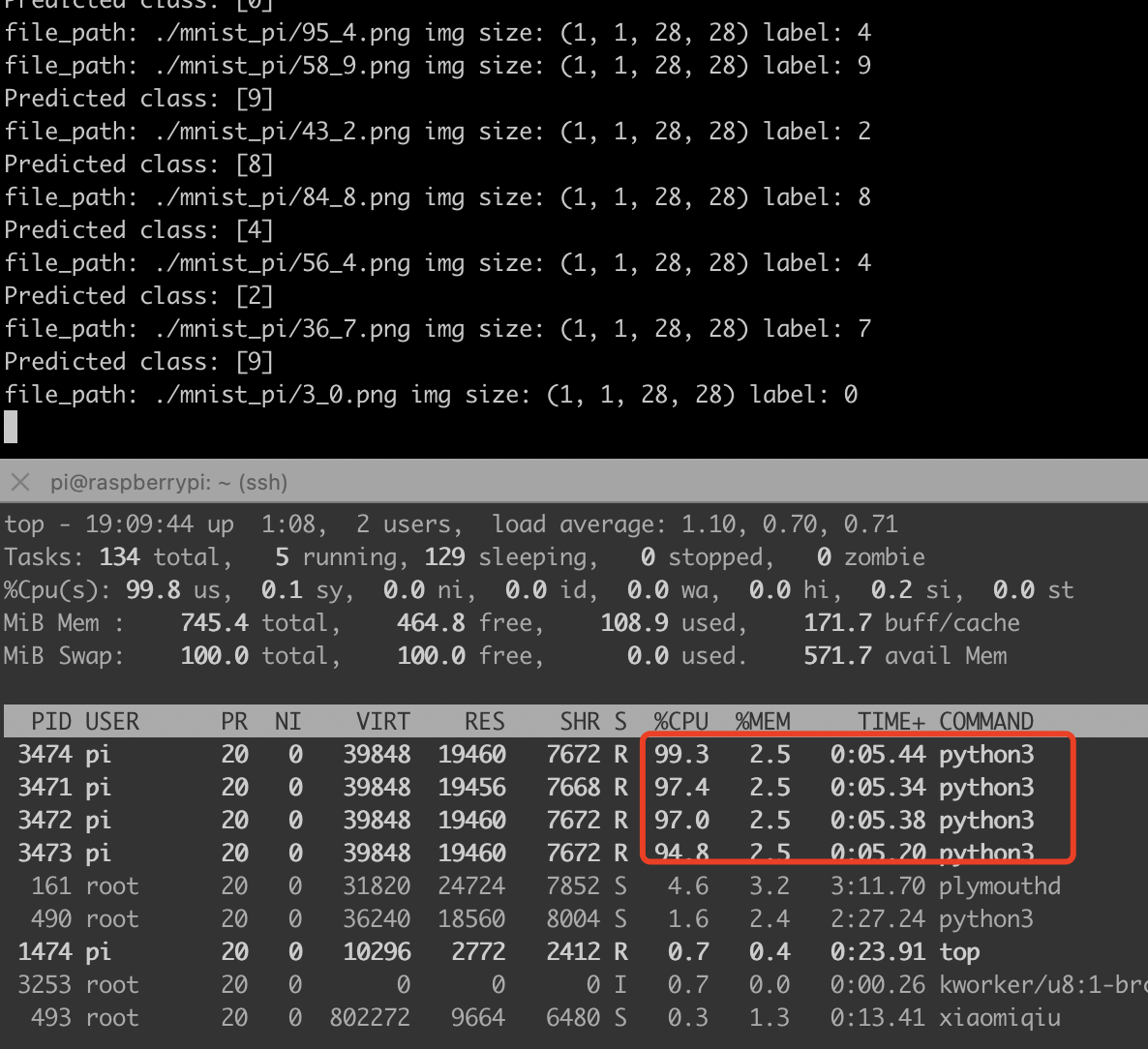在樹莓派上實現numpy的conv2d折積神經網路做影象分類,載入pytorch的模型引數,推理mnist手寫數位識別,並使用多程序加速
2023-05-30 21:00:38
這幾天又在玩樹莓派,先是搞了個物聯網,又在嘗試在樹莓派上搞一些簡單的神經網路,這次搞得是折積識別mnist手寫數位識別
訓練程式碼在電腦上,cpu就能訓練,很快的:
import torch import torch.nn as nn import torch.optim as optim from torchvision import datasets, transforms import numpy as np # 設定隨機種子 torch.manual_seed(42) # 定義資料預處理 transform = transforms.Compose([ transforms.ToTensor(), # transforms.Normalize((0.1307,), (0.3081,)) ]) # 載入訓練資料集 train_dataset = datasets.MNIST('data', train=True, download=True, transform=transform) train_loader = torch.utils.data.DataLoader(train_dataset, batch_size=64, shuffle=True) # 構建折積神經網路模型 class Net(nn.Module): def __init__(self): super(Net, self).__init__() self.conv1 = nn.Conv2d(1, 10, kernel_size=5) self.pool = nn.MaxPool2d(2) self.fc = nn.Linear(10 * 12 * 12, 10) def forward(self, x): x = self.pool(torch.relu(self.conv1(x))) x = x.view(-1, 10 * 12 * 12) x = self.fc(x) return x model = Net() # 定義損失函數和優化器 criterion = nn.CrossEntropyLoss() optimizer = optim.SGD(model.parameters(), lr=0.01, momentum=0.5) # 訓練模型 def train(model, device, train_loader, optimizer, criterion, epochs): model.train() for epoch in range(epochs): for batch_idx, (data, target) in enumerate(train_loader): data, target = data.to(device), target.to(device) optimizer.zero_grad() output = model(data) loss = criterion(output, target) loss.backward() optimizer.step() if batch_idx % 100 == 0: print(f'Train Epoch: {epoch+1} [{batch_idx * len(data)}/{len(train_loader.dataset)} ' f'({100. * batch_idx / len(train_loader):.0f}%)]\tLoss: {loss.item():.6f}') # 在GPU上訓練(如果可用),否則使用CPU device = torch.device("cuda" if torch.cuda.is_available() else "cpu") model.to(device) # 訓練模型 train(model, device, train_loader, optimizer, criterion, epochs=5) # 儲存模型為NumPy資料 model_state = model.state_dict() numpy_model_state = {key: value.cpu().numpy() for key, value in model_state.items()} np.savez('model.npz', **numpy_model_state) print("Model saved as model.npz")
然後需要自己在dataset裡匯出一些圖片:我儲存在了mnist_pi資料夾下,「_」後面的是標籤,主要是在pc端匯出儲存到樹莓派下

樹莓派推理端的程式碼,需要numpy手動重新搭建網路,並且需要手動實現conv2d折積神經網路和maxpool2d最大池化,然後載入那些儲存的矩陣引數,做矩陣乘法和加法
import numpy as np import os from PIL import Image def conv2d(input, weight, bias, stride=1, padding=0): batch_size, in_channels, in_height, in_width = input.shape out_channels, in_channels, kernel_size, _ = weight.shape # 計算輸出特徵圖的大小 out_height = (in_height + 2 * padding - kernel_size) // stride + 1 out_width = (in_width + 2 * padding - kernel_size) // stride + 1 # 新增padding padded_input = np.pad(input, ((0, 0), (0, 0), (padding, padding), (padding, padding)), mode='constant') # 初始化輸出特徵圖 output = np.zeros((batch_size, out_channels, out_height, out_width)) # 執行折積操作 for b in range(batch_size): for c_out in range(out_channels): for h_out in range(out_height): for w_out in range(out_width): h_start = h_out * stride h_end = h_start + kernel_size w_start = w_out * stride w_end = w_start + kernel_size # 提取對應位置的輸入影象區域 input_region = padded_input[b, :, h_start:h_end, w_start:w_end] # 計算折積結果 x = input_region * weight[c_out] bia = bias[c_out] conv_result = np.sum(x, axis=(0,1, 2)) + bia # 將折積結果儲存到輸出特徵圖中 output[b, c_out, h_out, w_out] = conv_result return output def max_pool2d(input, kernel_size, stride=None, padding=0): batch_size, channels, in_height, in_width = input.shape if stride is None: stride = kernel_size out_height = (in_height - kernel_size + 2 * padding) // stride + 1 out_width = (in_width - kernel_size + 2 * padding) // stride + 1 padded_input = np.pad(input, ((0, 0), (0, 0), (padding, padding), (padding, padding)), mode='constant') output = np.zeros((batch_size, channels, out_height, out_width)) for b in range(batch_size): for c in range(channels): for h_out in range(out_height): for w_out in range(out_width): h_start = h_out * stride h_end = h_start + kernel_size w_start = w_out * stride w_end = w_start + kernel_size input_region = padded_input[b, c, h_start:h_end, w_start:w_end] output[b, c, h_out, w_out] = np.max(input_region) return output # 載入儲存的模型資料 model_data = np.load('model.npz') # 提取模型引數 conv_weight = model_data['conv1.weight'] conv_bias = model_data['conv1.bias'] fc_weight = model_data['fc.weight'] fc_bias = model_data['fc.bias'] # 進行推理 def inference(images): # 執行折積操作 conv_output = conv2d(images, conv_weight, conv_bias, stride=1, padding=0) conv_output = np.maximum(conv_output, 0) # ReLU啟用函數 #maxpool2d pool = max_pool2d(conv_output,2) # 執行全連線操作 flattened = pool.reshape(pool.shape[0], -1) fc_output = np.dot(flattened, fc_weight.T) + fc_bias fc_output = np.maximum(fc_output, 0) # ReLU啟用函數 # 獲取預測結果 predictions = np.argmax(fc_output, axis=1) return predictions folder_path = './mnist_pi' # 替換為圖片所在的資料夾路徑 def infer_images_in_folder(folder_path): for file_name in os.listdir(folder_path): file_path = os.path.join(folder_path, file_name) if os.path.isfile(file_path) and file_name.endswith(('.jpg', '.jpeg', '.png')): image = Image.open(file_path) label = file_name.split(".")[0].split("_")[1] image = np.array(image)/255.0 image = np.expand_dims(image,axis=0) image = np.expand_dims(image,axis=0) print("file_path:",file_path,"img size:",image.shape,"label:",label) predicted_class = inference(image) print('Predicted class:', predicted_class) infer_images_in_folder(folder_path)
這程式碼完全就是numpy推理,不需要安裝pytorch,樹莓派也裝不動pytorch,太重了,下面是推理結果,比之前的MLP網路慢很多,主要是手動實現的折積網路全靠迴圈實現。

那我們給它加加速吧,下面是一個多執行緒加速程式:
import numpy as np import os from PIL import Image from multiprocessing import Pool def conv2d(input, weight, bias, stride=1, padding=0): batch_size, in_channels, in_height, in_width = input.shape out_channels, in_channels, kernel_size, _ = weight.shape # 計算輸出特徵圖的大小 out_height = (in_height + 2 * padding - kernel_size) // stride + 1 out_width = (in_width + 2 * padding - kernel_size) // stride + 1 # 新增padding padded_input = np.pad(input, ((0, 0), (0, 0), (padding, padding), (padding, padding)), mode='constant') # 初始化輸出特徵圖 output = np.zeros((batch_size, out_channels, out_height, out_width)) # 執行折積操作 for b in range(batch_size): for c_out in range(out_channels): for h_out in range(out_height): for w_out in range(out_width): h_start = h_out * stride h_end = h_start + kernel_size w_start = w_out * stride w_end = w_start + kernel_size # 提取對應位置的輸入影象區域 input_region = padded_input[b, :, h_start:h_end, w_start:w_end] # 計算折積結果 x = input_region * weight[c_out] bia = bias[c_out] conv_result = np.sum(x, axis=(0,1, 2)) + bia # 將折積結果儲存到輸出特徵圖中 output[b, c_out, h_out, w_out] = conv_result return output def max_pool2d(input, kernel_size, stride=None, padding=0): batch_size, channels, in_height, in_width = input.shape if stride is None: stride = kernel_size out_height = (in_height - kernel_size + 2 * padding) // stride + 1 out_width = (in_width - kernel_size + 2 * padding) // stride + 1 padded_input = np.pad(input, ((0, 0), (0, 0), (padding, padding), (padding, padding)), mode='constant') output = np.zeros((batch_size, channels, out_height, out_width)) for b in range(batch_size): for c in range(channels): for h_out in range(out_height): for w_out in range(out_width): h_start = h_out * stride h_end = h_start + kernel_size w_start = w_out * stride w_end = w_start + kernel_size input_region = padded_input[b, c, h_start:h_end, w_start:w_end] output[b, c, h_out, w_out] = np.max(input_region) return output # 載入儲存的模型資料 model_data = np.load('model.npz') # 提取模型引數 conv_weight = model_data['conv1.weight'] conv_bias = model_data['conv1.bias'] fc_weight = model_data['fc.weight'] fc_bias = model_data['fc.bias'] # 進行推理 def inference(images): # 執行折積操作 conv_output = conv2d(images, conv_weight, conv_bias, stride=1, padding=0) conv_output = np.maximum(conv_output, 0) # ReLU啟用函數 # maxpool2d pool = max_pool2d(conv_output, 2) # 執行全連線操作 flattened = pool.reshape(pool.shape[0], -1) fc_output = np.dot(flattened, fc_weight.T) + fc_bias fc_output = np.maximum(fc_output, 0) # ReLU啟用函數 # 獲取預測結果 predictions = np.argmax(fc_output, axis=1) return predictions labels = [] preds = [] def infer_image(file_path): image = Image.open(file_path) label = file_path.split("/")[-1].split(".")[0].split("_")[1] image = np.array(image) / 255.0 image = np.expand_dims(image, axis=0) image = np.expand_dims(image, axis=0) print("file_path:", file_path, "img size:", image.shape, "label:", label) predicted_class = inference(image) print('Predicted class:', predicted_class) folder_path = './mnist_pi' # 替換為圖片所在的資料夾路徑 pool = Pool(processes=4) # 設定程序數為2,可以根據需要進行調整 def infer_images_in_folder(folder_path): for file_name in os.listdir(folder_path): file_path = os.path.join(folder_path, file_name) if os.path.isfile(file_path) and file_name.endswith(('.jpg', '.jpeg', '.png')): pool.apply_async(infer_image, args=(file_path,)) pool.close() pool.join() infer_images_in_folder(folder_path)
下圖可以看出來,我的樹莓派3b+,cpu直接拉滿,速度提升4倍:

多思考也是一種努力,做出正確的分析和選擇,因為我們的時間和精力都有限,所以把時間花在更有價值的地方。